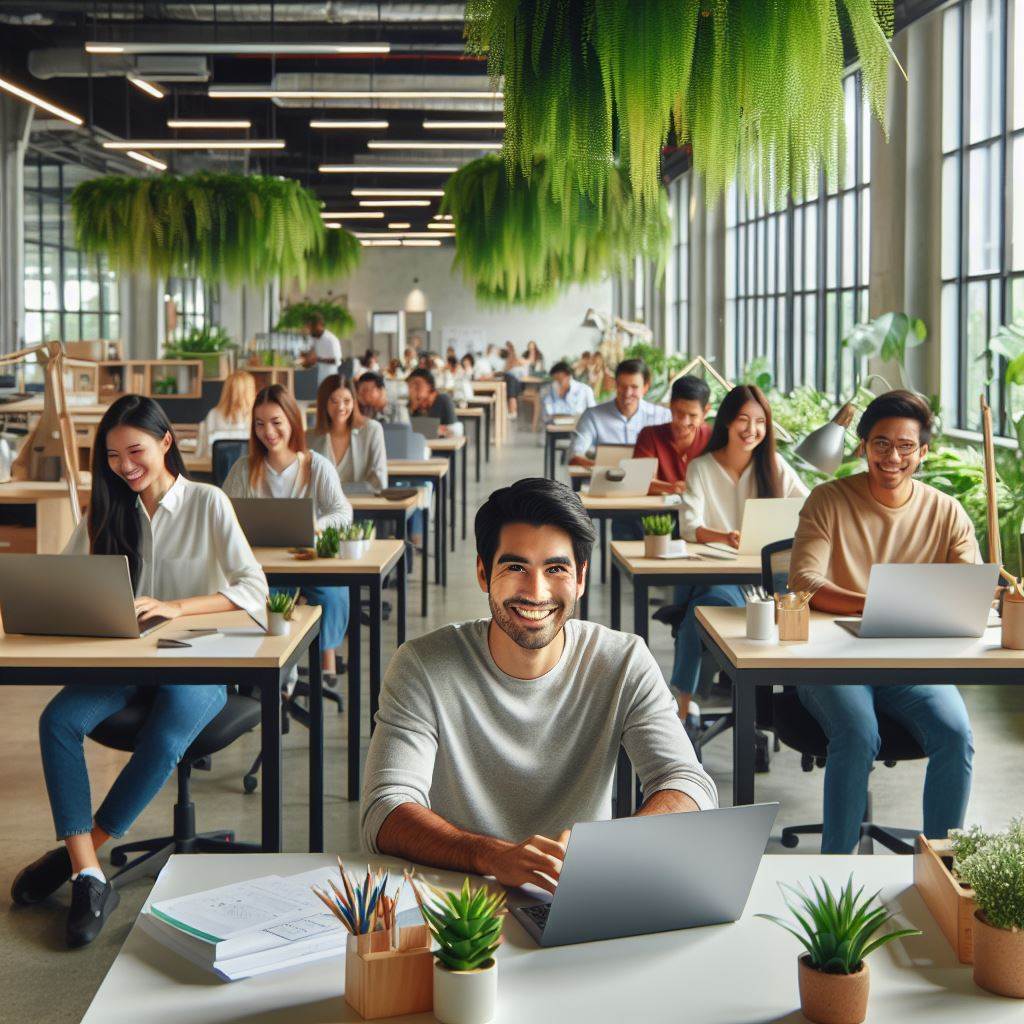Introduction
The aftermath of the COVID-19 pandemic has triggered a significant transformation in the landscape of office spaces across the United States.
As organizations grapple with the implications of a global health crisis, the discussion surrounding post-COVID office spaces has never been more pertinent.
Delving deeper into this topic reveals not only the necessity but also the urgency of understanding and adapting to the new paradigms shaping work environments.
A. Importance of discussing post-COVID office spaces
Importantly, the discussion on post-COVID office spaces transcends mere architectural or logistical considerations.
It touches upon fundamental aspects of workplace culture, employee well-being, and organizational resilience.
The pandemic has underscored the importance of prioritizing health and safety measures in shared workspaces, prompting a reevaluation of traditional office layouts and practices.
B. Overview of the changes observed in US office spaces
One of the most conspicuous changes observed in US office spaces is the emphasis on flexibility and adaptability.
Companies are increasingly adopting hybrid models that allow employees to alternate between remote work and in-person collaboration.
This shift not only accommodates diverse work preferences but also enhances productivity and work-life balance.
Moreover, the layout and design of office spaces have undergone a fundamental overhaul to align with new health protocols.
From reconfiguring desk arrangements to implementing touchless technology and improving ventilation systems, these changes aim to mitigate the risk of viral transmission and create a safer working environment for employees.
Furthermore, the pandemic has accelerated the adoption of technology-driven solutions in office spaces.
Virtual collaboration tools, digital communication platforms, and cloud-based systems have become indispensable for remote work and seamless connectivity between dispersed teams.
In essence, the discussion on post-COVID office spaces encapsulates the multifaceted challenges and opportunities facing organizations in the wake of a global health crisis.
By exploring the evolving dynamics of workplace design, safety protocols, and technological integration, businesses can navigate the complexities of the new normal and cultivate resilient, future-ready work environments.
Pre-COVID Office Spaces
Before the COVID-19 pandemic, office spaces had a particular layout and design that were widely adopted.
A. Traditional office layouts and designs
- They typically consisted of cubicles or individual offices for employees.
- Common areas like break rooms and conference rooms were also present.
- The design was focused on maximizing space efficiency and promoting collaboration.
B. Open floor plan trend
- The open floor plan trend gained popularity, as it aimed to foster communication and teamwork.
- Workstations were placed in a shared space without walls or barriers, encouraging interaction.
- It was believed that this layout enhanced creativity, innovation, and productivity.
C. Advantages and disadvantages of pre-COVID office spaces
1. Advantages
- Open communication and easy accessibility between team members.
- Cost-effective use of office space, accommodating more employees.
- Opportunities for spontaneous collaboration and idea-sharing.
2. Disadvantages
- Lack of privacy and noise distractions affecting concentration.
- Higher chances of spreading illnesses in close proximity.
- Limited personalization in work areas due to shared space.
As evident from the advantages and disadvantages, pre-COVID office spaces had their pros and cons.
The COVID-19 pandemic has significantly impacted the way office spaces are designed and utilized.
Read: Green Buildings: US Market Trends 2024
Impact of COVID-19 on Office Spaces
The COVID-19 pandemic has brought about a seismic shift in the way offices operate.
Overnight, companies were forced to abandon traditional office spaces and transition to remote work.
This sudden change disrupted the normal flow of business operations but also highlighted the resilience and adaptability of organizations.
A. The sudden shift to remote work during the pandemic
One of the most significant impacts of the pandemic on office spaces was the sudden shift to remote work.
With the widespread transmission of the virus, companies had to prioritize the health and safety of their employees.
This meant enabling them to work from the comfort and safety of their own homes.
The transition to remote work was swift, and employees had to quickly adjust to a new way of working.
B. Importance of social distancing and hygiene measures
The importance of social distancing and hygiene measures cannot be overstated in the context of office spaces during the pandemic.
Physical distancing became the norm, and companies had to implement measures to ensure employees’ safety.
This included rearranging workspaces, limiting the number of employees in the office, and promoting good hygiene practices such as regular handwashing and sanitization.
C. Challenges faced by companies in adapting to remote work
While the shift to remote work and implementing safety measures were necessary, it also presented numerous challenges for companies.
1. Lack of infrastructure and technology
One of the major hurdles faced was the lack of infrastructure and technology to support remote work on such a large scale.
Companies had to quickly invest in the necessary tools and equipment to enable their employees to work effectively from home.
2. Maintaining a sense of connection and collaboration
Another challenge was maintaining a sense of connection and collaboration among remote teams.
Office spaces provided a physical environment where employees could interact, brainstorm ideas, and build relationships.
With remote work, companies had to find innovative ways to foster teamwork and communication.
Virtual meetings and collaboration tools became essential in bridging the physical gap between employees.
Furthermore, mental health and wellbeing emerged as critical considerations for companies during the pandemic.
The isolation and uncertainty brought about by remote work took a toll on many employees.
Employers had to prioritize mental health support and offer resources such as counseling services and virtual team-building activities to combat the negative effects of prolonged remote work.
Looking ahead, the impact of the pandemic on office spaces is likely to be long-lasting.
Many companies have realized the benefits of remote work and are considering adopting hybrid models that combine in-person and remote work.
This shift may lead to a transformation in the design and layout of office spaces, with a focus on creating collaborative areas and providing flexible work options for employees.
In short, the COVID-19 pandemic has had a profound impact on office spaces in the United States.
The sudden shift to remote work, the importance of social distancing and hygiene measures, and the challenges faced by companies in adapting to this new work environment have reshaped the way organizations operate.
As we emerge from the pandemic, the future of office spaces remains uncertain, but it is clear that flexibility and adaptability will be essential for success in the post-COVID-19 world.
Read: Tech Impact on US Commercial Real Estate
Trends and Changes in Post-COVID Office Spaces
As the world begins to emerge from the COVID-19 pandemic, office spaces are also undergoing significant changes.
These trends are shaping the future of work and influencing how businesses adapt to the new normal.
In this section, we will explore some of the key trends and changes in post-COVID office spaces.
A. Flexible and Hybrid Work Models
The pandemic has accelerated the adoption of flexible and hybrid work models.
Companies are realizing that employees can be productive even when working remotely.
As a result, many organizations are implementing policies that allow for a combination of remote and in-office work.
This flexibility not only improves work-life balance but also reduces the need for large, traditional office spaces.
B. Health and Safety Protocols
Health and safety protocols have become a top priority in post-COVID office spaces.
Employers are implementing measures to ensure the well-being of their employees.
This includes regular sanitization, social distancing, and the availability of hand sanitizers and disinfectants.
Meeting rooms and common areas are being redesigned to accommodate these protocols and ensure a safe working environment.
C. Redesigned Layouts and Furniture Arrangements
Office layouts are being reimagined to adhere to social distancing guidelines.
Open-plan office spaces, which were once popular, are now being replaced with divided work stations and barriers.
Furniture arrangements are being adjusted to maintain a safe distance between employees.
This redesigned layout not only minimizes the risk of transmission but also provides a sense of security and reassurance for employees.
D. Integration of Technology and Digital Tools
The pandemic has highlighted the importance of technology in maintaining business operations.
Office spaces are now being equipped with advanced communication tools and collaboration software.
Video conferencing has become the norm for meetings, and digital project management tools are being used to ensure seamless coordination among remote teams.
The integration of technology not only facilitates remote work but also enhances productivity and efficiency.
In general, post-COVID office spaces are undergoing significant changes to adapt to the new normal.
Flexible and hybrid work models, emphasis on health and safety protocols, redesigned layouts, and the integration of technology are key trends in the evolving office environment.
These changes aim to create a safe working environment while promoting collaboration and productivity.
As businesses navigate the post-pandemic era, these trends will continue to shape the future of work and redefine the traditional office space.
Read: US Warehouse Market: 2024 Growth Insights

Importance of Employee Well-being
A. Focus on prioritizing mental and physical health
Employee well-being is of utmost importance in post-Covid US office spaces.
Companies are now focusing on prioritizing the mental and physical health of their employees.
B. Incorporation of wellness and relaxation areas
One way they are achieving this is through the incorporation of wellness and relaxation areas within the office.
These spaces provide employees with a dedicated place to unwind and de-stress during the workday.
These wellness areas may include comfortable seating, calming colors, and even features such as meditation rooms or yoga studios.
By providing employees with these spaces, companies are showing their commitment to their well-being.
C. Introduction of green spaces and natural lighting
In addition to wellness areas, post-Covid office spaces are also introducing green spaces and natural lighting.
Research has shown that exposure to nature and natural light can have a positive impact on both mental and physical health.
Green spaces within the office can be in the form of indoor plants or even rooftop gardens and balconies.
These spaces not only improve air quality but also provide a visually pleasing environment for employees to work in.
Natural lighting is being prioritized by incorporating large windows and skylights into office designs.
This allows for maximum exposure to sunlight, which has been proven to boost mood and productivity.
By incorporating these elements into office spaces, companies are creating a more conducive environment for employee well-being.
Happy and healthy employees are more likely to be engaged and productive in their work.
D. Realization of the importance of promoting work-life balance
Furthermore, companies are also recognizing the importance of promoting work-life balance for their employees.
Post-Covid office spaces are being designed with flexible work arrangements in mind.
Remote work options, flexible schedules, and the ability to work from different locations are becoming more commonplace.
This allows employees to better manage their personal lives and commitments while still meeting work requirements.
By giving employees the autonomy to decide where and when they work, companies are fostering a sense of trust and empowerment.
This can have a positive impact on employee morale and job satisfaction.
Overall, the importance of employee well-being cannot be underestimated in post-Covid US office spaces.
Companies are realizing the benefits of prioritizing mental and physical health and are implementing various strategies to support their employees in achieving this.
From wellness areas and green spaces to flexible work arrangements, these changes are transforming the traditional office space into a more employee-centric environment.
By investing in employee well-being, companies are not only ensuring the health and happiness of their workforce but also improving overall productivity and success.
Read: Future of Office Real Estate in the US
Adoption of New Technologies
The post-Covid era has brought about significant changes in the way office spaces operate.
As companies strive to create a safer and more efficient work environment, they are adopting new technologies that can enhance productivity and support remote collaboration.
A. Increased reliance on video conferencing and collaboration tools
Video conferencing has become an integral part of the modern workplace, allowing teams to communicate and collaborate effectively, regardless of their geographical locations.
With the advent of the pandemic, this reliance on video conferencing tools has only increased.
Virtual meetings have proven to be a viable alternative to in-person gatherings, reducing the need for employees to travel and eliminating the risk of virus transmission.
Platforms like Zoom, Microsoft Teams, and Google Meet have seen a surge in popularity and are now essential tools for conducting meetings and sharing information.
B. Integration of smart office technologies
Smart office technologies offer a range of benefits, including improved energy efficiency, increased security, and enhanced employee comfort.
These technologies are now being widely adopted to create a more connected and intelligent workspace.
Smart lighting systems, for example, use sensors to detect occupancy and adjust lighting levels accordingly, reducing energy waste.
Similarly, smart thermostats can optimize temperature settings based on occupancy patterns, ensuring a comfortable working environment while minimizing energy consumption.
Moreover, smart access control systems provide enhanced security by allowing employees to access the workplace using their smartphones or biometric authentication, eliminating the need for physical keys or access cards.
C. Implementation of touchless systems and automation
One significant change observed in post-Covid office spaces is the implementation of touchless systems and automation to reduce the risk of virus transmission.
Touchless technologies, such as automatic doors, voice-activated elevators, and motion sensor-equipped faucets, minimize the need for physical contact and help maintain a hygienic workplace environment.
Automation plays a crucial role in streamlining various tasks, from temperature and humidity control to reservation and scheduling systems.
For instance, automated cleaning robots can efficiently sanitize workstations and common areas, ensuring a clean and safe working environment for employees.
Furthermore, artificial intelligence-powered chatbots and virtual assistants can provide employees with instant support and information, reducing the need for face-to-face interactions.
In review, the post-Covid era has witnessed the accelerated adoption of new technologies in office spaces.
Video conferencing and collaboration tools have become essential for remote collaboration, while smart office technologies have improved efficiency and security.
Touchless systems and automation have also been implemented to reduce the risk of virus transmission.
As offices continue to evolve, the integration of these technologies will play a vital role in shaping the future of work.
Reimagining Common Spaces
During the post-Covid era, office spaces in the US are undergoing significant transformations.
Common areas like cafeterias and lounges are being reimagined to meet new requirements for health and safety.
A. Transformation of Common Areas
The traditional concept of cafeterias and lounges is being revamped as employers prioritize the well-being of their employees.
These spaces are now designed to ensure social distancing, with rearranged seating arrangements and limited capacity.
Moreover, the materials used for furniture and surfaces are being carefully chosen to facilitate easy sanitization and disinfection.
Antimicrobial and easy-to-clean materials are preferred to minimize the risk of virus transmission.
B. Introduction of Multipurpose Spaces
Office spaces are now incorporating multipurpose spaces that serve as meeting rooms and collaborative areas.
These flexible spaces can be easily adapted to suit different needs, such as brainstorming sessions or client presentations.
By utilizing these multipurpose spaces, companies can optimize their office layout, reduce unnecessary square footage, and foster a collaborative work environment.
C. Provision of Private Workstations and Individual Pods
In response to the need for social distancing, office spaces are providing private workstations and individual pods.
These enclosed spaces offer employees a safe and isolated environment, minimizing the risk of virus transmission.
These workstations and pods are creatively designed to ensure comfort, productivity, and privacy.
They are equipped with necessary amenities like ergonomic furniture, adjustable lighting, and soundproofing materials.
D. Embracing the New Office Landscape
The transformations in common spaces reflect the adaptability and resilience of the US office landscape.
The focus on employee well-being and safety has become crucial for businesses to thrive in the post-Covid era.
By reimagining common spaces, employers can create a workplace that not only adheres to health guidelines but also fosters collaboration, creativity, and productivity.
These changes also provide an opportunity for companies to embrace a hybrid work model, where employees have the flexibility to work remotely or in the office.
The reimagined common spaces serve as a hub for collaboration and social interaction when employees do come into the office.
In a nutshell, the post-Covid US office spaces are witnessing a transformation in common areas.
Redesign cafeterias and lounges with health and safety in mind, enabling social distancing and sanitization.
Introduce multipurpose spaces to maximize office space utilization, encourage collaboration, and foster creativity.
Private workstations and individual pods offer employees a safe and isolated environment.
As the office landscape evolves, embracing these changes will not only ensure the well-being of employees but also lead to a more resilient and productive work environment.
Impact on Commercial Real Estate Market
In the wake of the COVID-19 pandemic, the commercial real estate market is experiencing significant changes, driven by shifting demand and evolving preferences.
A. The Changing Demand and Preferences
- Remote Work Revolution: The pandemic has accelerated the adoption of remote work, leading to a decrease in the demand for large office spaces.
- Work-Life Balance: Employees’ focus on work-life balance has increased, leading to a preference for more flexible work arrangements.
- Health and Safety Concerns: The pandemic has created a heightened awareness of health and safety, necessitating changes in office space design and layout.
- Innovation and Collaboration: Companies are reimagining office spaces to foster innovation and collaboration, utilizing technology and interactive environments.
- Talent Attraction: Employers are recognizing the importance of providing attractive office spaces to attract and retain top talent.
B. Potential Decrease in Demand for Large Office Spaces
- Remote Work Trends: As more companies adopt remote work policies, there is a reduced need for large office spaces to accommodate a full workforce.
- Cost Savings: Downsizing office spaces can result in significant cost savings for businesses, making it an attractive option in uncertain economic times.
- Shift in Work Culture: The pandemic has altered the perception of traditional office spaces, making remote work and flexible arrangements more desirable.
- Evolving Business Models: Many organizations have realized the feasibility of remote work and are restructuring their business models accordingly.
- Hybrid Work Models: A combination of remote work and in-office presence is emerging as a preferred approach, reducing the need for extensive office spaces.
C. Emerging Opportunities for Flexible and Smaller Office Spaces
- Co-Working Spaces: The demand for co-working spaces is expected to rise as individuals and small businesses seek affordable and flexible alternatives.
- Shared Office Services: Companies offering shared office services can capitalize on the growing demand for flexible spaces without long-term commitments.
- Private Workspace Options: Renting smaller, private workspaces can provide individuals and small teams with the necessary office infrastructure and amenities.
- Remote Work Hubs: Organizations can establish remote work hubs designed for collaboration and productivity, allowing employees to work closer to home.
- Customizable Office Solutions: Real estate developers can focus on offering customizable office solutions that cater to the changing needs of businesses.
- Repurposing Office Spaces: Vacant office spaces can be repurposed to meet new demands, such as converting them into mixed-use developments or residential units.
- Proximity to Amenities: Smaller office spaces located near amenities like food outlets, fitness centers, and green spaces can enhance the overall work experience.
- Flexible Lease Terms: Landlords can attract tenants by offering flexible lease terms that align with the fluctuating demands and requirements of businesses.
- Technology Integration: Office spaces should incorporate technology to support remote collaboration, virtual meetings, and seamless connectivity.
- Health and Safety Measures: Office spaces must implement enhanced health and safety measures, such as improved ventilation systems and contactless facilities.
Basically, the post-COVID era has brought about a transformation in the commercial real estate market.
Decreasing demand for large office spaces and rising flexible options create opportunities for businesses.
Conclusion
The changes in US office spaces post-COVID have been significant.
Open floor plans and shared spaces are being replaced with social distancing measures and increased hygiene protocols.
Remote work and flexible schedules are also becoming more common.
Despite these changes, the future of US office spaces remains uncertain. It is crucial for companies to adapt and remain responsive to future challenges.
This may involve investing in technology to support remote work, implementing flexible work arrangements, and prioritizing employee well-being and safety.
The COVID-19 pandemic has forced a reimagining of office spaces in the US.
Companies must embrace agile approaches to meet employees’ evolving needs and adapt to the changing business landscape.
By doing so, they can create a productive and safe work environment while thriving in the new normal.




